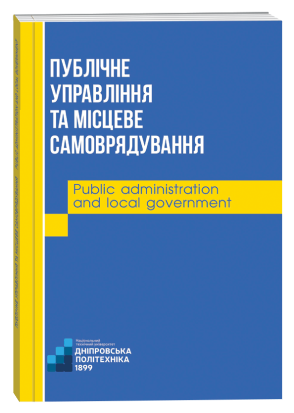PUBLIC-PRIVATE PARTNERSHIP AS INNOVATIVE TOOL FOR IMPLEMENTATION OF STATE YOUTH EMPLOYMENT POLICY AT REGIONAL LEVEL
DOI:
https://doi.org/10.33287/102046Keywords:
public-private partnership, state youth employment policy at regional levelAbstract
One of the ways to implement the state policy in the sphere of youth employment and incentives for creation of new jobs for the period up to 2022 was defined by the Cabinet of Ministers of Ukraine as encouragement of partnership between the public authorities, employers, and educational establishments in the labour market. This is the evidence of a growing social need for using public- private partnership with the aim to ensure youth employment at the regional level. The specific features of implementing public-private partnership in various spheres have been studied by a number of the Ukrainian and foreign researchers, in particular: J. Delmon, І. Drobot, О. Fomenko, К. Khlebnykov, N. Кlievtsievych, М. Lakhyzha, М. Маsyk, P. Shylepnytskyi, S. Yehorycheva and other scholars. At the same time, there are still unexplored issues of the areas and possibilities of using public- private partnership in the field of youth employment at the regional level. The paper objective is substantiation of the assumption that public-private partnership is an innovative tool for implementing the state youth employment policy at the regional level. Systematizing of scientific approaches to determining the essence of public-private partnership makes it possible to characterize it as an innovative tool, business model, and cooperation. The use of public-private partnership is based on certain special principles, specifically: adaptation capacity, which presupposes elaboration of a variety of options for the technology of implementation of the public-private partnership mechanism in the youth employment sphere; and socialization of the youth in the country’s regions. The characteristic features of public-private partnership in the sphere of youth employment are: perception of the youth employment at the regional level as a socially significant problem; the need for creating jobs with regard to the specificity of every particular territory, including its employment and unemployment rates; the relevance of encouraging a continuous development of public-private partnership, taking into account youth employment transformation; getting the youth involved in social labour as a prerequisite for improvement of regional competitive capacity. Partnership between the public and private sectors is a necessary and effective instrument of state youth employment policy at the regional level. The use of public-private partnership in the sphere of youth employment will promote creation of new jobs, conditions for realization of young specialists’ personal potential, implementation of their start-ups, increasing the contribution of young people in the socio-economic development of the regions. The above mentioned affords grounds to regard public-private partnership as an innovative tool of the state youth employment policy at the regional level. The prospects for further scientific surveys consist in substantiation of using public- private partnership for ensuring youth employment in the country’s depressed regions with respect to specific features of regional development.
References
Дробот І. О., Барбір І. М. Механізм державно-приватного партнерства у сфері транспортноУ інфраструктури УкраУни. Ефективність державного управління: зб. наук. пр. 2019. Вип. 4(61). C. 98 – 109.
Зміни до ТериторіальноУ угоди між Харківською обласною державною адміністрацією, Спільними представницькими органами сторін роботодавців та профспілок ХарківськоУ області на 2016 – 2018 роки: зареєстровано Міністерством соціальноУ політики від 15 лют. 2019 р. URL: https://www.msp.gov.ua/files/ugody/ter/22-4.pdf (дата звернення: 01.07.2020).
Клєвцєвич Н. А. Державно-приватне партнерство як інструмент регіонального розвитку. Економіка і суспільство. 2017. Вип. 9. С. 237 – 241.
Комарницька Г. О. Активізування державно-приватного партнерства в умовах розвитку інвестиційно-інноваційноУ діяльності: дис. … д-ра екон. наук: 08.00.03. Львів: [б. в.], 2020. 469 с.
Лахижа М. І., Єгоричева С. Б. Публічно-приватне партнерство у Республіці Польща: становлення та розвиток. Ефективність держ. упр.: зб. наук. пр. 2019. Вип. 1(58). C. 36 – 51.
Масик М. З. Організаційно-правовий механізм державно-приватного партнерства у житлово-комунальній сфері УкраУни: дис. … канд. наук з держ. упр. 25.00.02. КиУв: [б. в.], 2018. 249 с.
Павлюк К. В., Павлюк С. М. Сутність і роль державно-приватного партнерства в соціально-економічному розвитку держави. Наук. пр. Кіровоград. нац. техніч. ун-ту. Сер. «Економічні науки». 2010. Вип. 17. С. 10 – 19.
Постніков В. Особливості застосування державно-приватного партнерства як регулятора розвитку міського транспорту. Глобальні та національні проблеми економіки. 2018. № 23. С. 104 – 108.
Про державно-приватне партнерство: Закон УкраУни від 1 лип. 2010 р. № 2404-VI. Відом. Верховноі" Ради Украі"ни. 2010. № 40. Ст. 524.
Про схвалення КонцепціУ реформування місцевого самоврядування та територіальноУ організаціУ влади в УкраУні: розпорядження Кабінету Міністрів УкраУни від 1 квіт. 2014 р. № 333-р. URL: https://zakon.rada.gov.ua/laws/show/333-2014-%D1%80 (дата звернення: 01.07.2020).
Резниченко Н. В. Модели государственно-частного партнерства. Вестн. Санкт- Петербург. ун-та. Сер. «Менеджмент». 2010. Вьп. 4. С. 58 – 83.
Хлебников К. В. Государственно-частное партнерство: зкономическое содержание и институциональнье границь. Зкономика и управление. 2011. № 7(80). С. 131 – 135.
Шилепницький П. І. Державно-приватне партнерство: теорія і практика: монографія. Чернівці: [б. в.], 2011. 455 с.
Public-Private Partnerships: the enabling environment for development. Retrieved from https://unpan1.un.org/intradoc/public/documents/un/unpan000727.pdf.
Ter-Minassian, T. (Ed.) (2004). Public-Private Partnerships. Washington D. C. Retrieved from https://www.imf.org/external/np/fad/2004/pifp/eng/031204.pdf.






